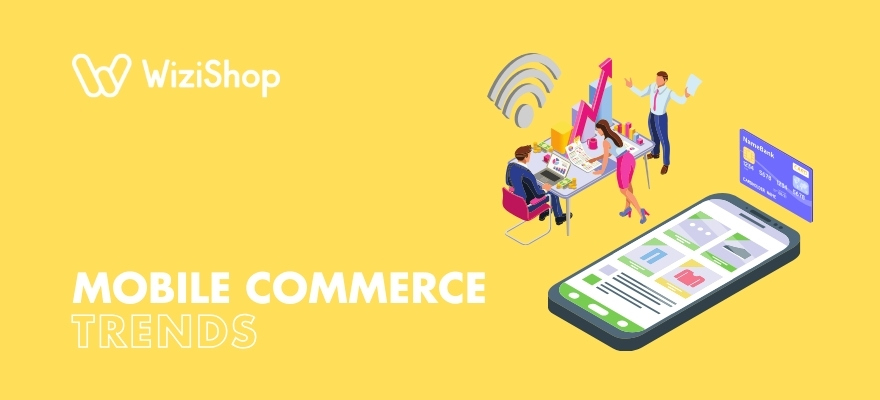For the last few decades, ecommerce has dramatically increased in popularity among shoppers. Because of the convenience and ease of buying online, this method is preferred by many shoppers around the world today.
In more recent years, ecommerce statistics have shown that with mobile device users being at an all-time high, mobile shopping has increasingly dominated the industry. Although nothing’s set in stone, it’s safe to assume mobile commerce (m-commerce) will continue to play a role in the future of ecommerce.
As the ecommerce landscape evolves, mobile trends are reshaping how consumers shop and interact with online retailers. With smartphones becoming the primary device for internet access, businesses must adapt to capture this mobile-centric market.
This article explores key mobile commerce trends, such as mobile-optimized websites, responsive design, and the growing use of mobile apps for online shopping. We will also take a closer look at how these ecommerce trends impact user experience, customer engagement, and ultimately, your bottom line. Get ready to stay ahead in the mobile-driven ecommerce world!
M-commerce continues to evolve, and it’s shaping consumer buying trends in the process. Because of the increasing prevalence of web purchases, ensure that your site has the necessary functions of electronic commerce to adapt accordingly.
In addition, you must keep an eye on trends and developments that may impact ecommerce activities going forward. This enables you to strategically improve relevant aspects of your operations to take advantage of the growth in this area.
Here are some of the top trends that you should be aware of today.
Table of contents
- 1. Popularity of using mobile apps to shop is growing
- 2. Trust in mobile shopping is increasing
- 3. Responsive mobile site design is becoming increasingly important
- 4. Smartphones are the most common device for online purchases in the US
- 5. One-click ordering on mobile phones is increasing
- 6. More and more brands are availing of social commerce and shoppable content
- 7. Accessibility is playing an increasingly crucial role in mobile web design
- 8. Online shopping via voice apps is growing in popularity
- 9. Brands are taking advantage of innovations in mobile chatbots
- 10. Augmented reality (AR) technology is becoming more prevalent
- 11. More businesses are allowing for mobile in-store checkout
- 12. Fraud in mobile shopping remains a challenge
- 13. Brands are using zero-party data for personalization
- 14. Mobile payments are more popular than ever
- 15. Omnichannel integrations are improving
1. Popularity of using mobile apps to shop is growing
While m-commerce covers all types of online shopping experiences conducted through a mobile device, many people are increasingly choosing to shop specifically through apps, whether for researching, making purchases, or both, bypassing using a browser for these activities altogether.
In fact, eMarketer reveals that data from a November 2023 Marigold survey shows that 52% of adults around the world have purchased something via a mobile app.
This trend highlights the interest in developing a well-designed mobile app for your customers to use as desired. Limiting the options to your customers could unnecessarily limit your ecommerce business’s income potential.

Sezane’s mobile shopping app in the Google Play Store
Here are a few tips to consider if you decide to create a mobile app to improve the shopping experience for consumers.
- Prioritize user-friendly design (UX/UI): Keep the interface clean, intuitive, and easy to navigate, also including clear icons, readable fonts, and consistent branding. Think about incorporating a simple onboarding process to help users get started quickly.
- Optimize for mobile performance: Ensure fast load times and smooth transitions between screens. In addition, you’ll want to design for responsiveness across devices with different sizes and screen resolutions. To help minimize app crashes and bugs, remember to do regular testing and updates.
- Incorporate personalization and convenience features: Offer personalized recommendations based on browsing and purchase history. Make checking out super simple by enabling easy payment options like one-tap checkout, digital wallets, and saved payment info. You might also opt to integrate push notifications for order updates, promotions, and personalized deals.
2. Trust in mobile shopping is increasing
Consumers are becoming increasingly trusting of the security of buying on the internet. This is directly impacting the popularity of making mobile purchases.
While some aspects of this increased level of trust are directly tied to shoppers’ familiarity with this process, others are tied to improvements in security.
To encourage your customers to have continued confidence with making purchases on your site, keep up to date trends in web and mobile security. You should also clearly illustrate the measures that your company is taking by displaying security badges and logos on your mobile app and website.
3. Responsive mobile site design is becoming increasingly important
Responsive mobile site design is crucial for ecommerce businesses aiming to enhance user experience and capitalize on the growing trend of mobile shopping. However, shoppers often encounter issues with mobile websites that deter purchases.
Common complaints include poor design, intrusive pop-ups, and missing information, which can erode trust and prompt users to abandon the site. Moreover, according to Google, if a mobile site takes longer than three seconds to load, users are likely to leave, emphasizing the requirement for fast, responsive pages.
By implementing responsive design, you can ensure that your website adapts seamlessly to various screen sizes and devices, providing a consistent and user-friendly experience. This approach will not only address consumer pain points but also enhance engagement, reduce your bounce rate, and ultimately boost your conversion rate.
4. Smartphones are the most common device for online purchases in the US
When you examine m-commerce more closely, you will see that it’s largely broken down into purchases that are executed on smartphones and on tablets. It’s easy to assume that these would be relatively similar and would not require individual analysis.
However, it's worth noting that there’s a big difference between sales on smartphones vs. tablets.
According to a 2023 Statista survey, when determining what devices were most popular with consumers in the US when it comes to purchasing products and services online, smartphones came out on top, even beating out laptops, with 73% of participants stating they used a smartphone for their ecommerce orders.
And while tablets came in 3rd place, the share of participants stating they used a tablet for their ecommerce orders was much lower at just 29%.
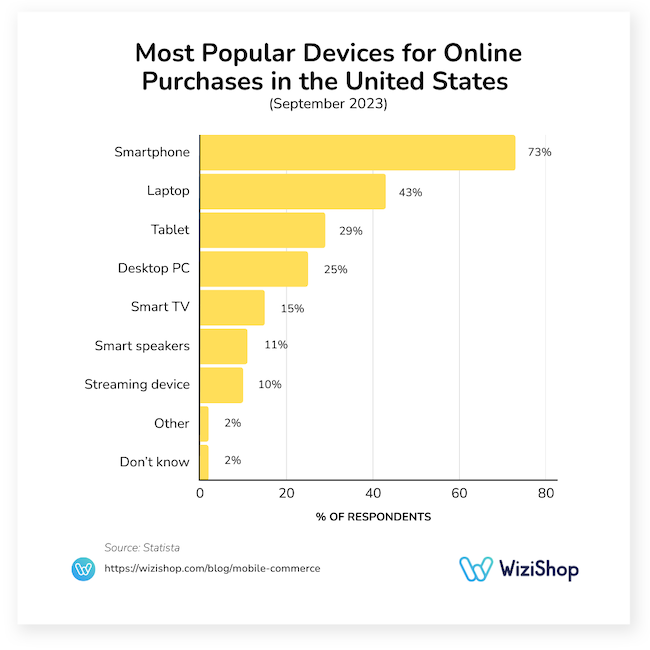
What does this trend mean for your company?
One important impact is that location-based push notifications and push notifications in general may be increasingly beneficial. This is because push notifications are most often received in real-time on smartphones rather than on tablets.
While you shouldn’t lose sight of the tremendous opportunities to connect with consumers through tablets, this trend indicates the need to cater to smartphone users.
5. One-click ordering on mobile phones is increasing
Users can easily grow annoyed and stressed when they are faced with a lengthy, complicated checkout process, regardless of the gadget they’re using. The smaller display screens of smartphones and tablets can increase the challenge of filling out long checkout forms.
One-click ordering is one of the top ecommerce innovations preferred by today’s shoppers, and it’s increasingly becoming an expected convenience.
The cart abandonment rate is extraordinarily high with mobile websites, but it drops dramatically for purchases made on a mobile app. Both of these actions would be completed on the mobile device, but the difference lies in the process of checking out.
The abandonment rate drops significantly when customers have access to a one-click checkout via an app.
6. More and more brands are availing of social commerce and shoppable content
Social media has been an integral part of ecommerce businesses for years. It’s played roles in increasing awareness, promoting brand image, and more. However, getting followers to click from a social media post to a shop’s product page has been challenging until recently.
Social networks have evolved to facilitate social commerce.
For example, businesses can now tag products on Facebook and Instagram posts. When followers click on an item that interests them in these shoppable posts, they’re taken directly to the shop’s product page.
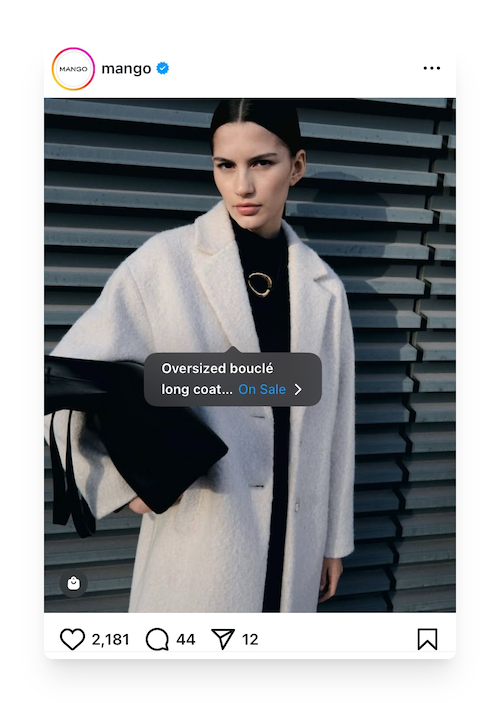
Instagram shoppable post by Mango
This streamlines the purchasing process and can potentially improve users’ experiences and a shop’s revenue-generation capabilities.
Keep in mind that many consumers already have Facebook and Instagram. By putting your products in their feeds, you’re placing these items directly in front of your target audience, using a platform that they’re already using.
7. Accessibility is playing an increasingly crucial role in mobile web design
Accessibility is becoming increasingly vital in mobile web design as businesses recognize the importance of inclusivity and user experience for all customers.
With approximately 1.3 billion people worldwide living with disabilities, according to the World Health Organization, ensuring mobile sites are accessible is not just ethical—it’s also a smart business move that can broaden your ecommerce brand’s reach. This trend is especially relevant as m-commerce continues to grow, and businesses aim to offer seamless experiences across diverse user needs.
So what does it mean to have an accessible mobile site?
An accessible mobile site allows all users—including those with visual, auditory, cognitive, or motor impairments—to navigate, interact, and complete purchases with ease. Designing for accessibility involves using readable fonts, clear color contrasts, descriptive alt text for images, voice command compatibility, and ensuring screen reader support. It also requires intuitive navigation and touch-friendly buttons.
A good example of an accessible website is outdoor clothing company Patagonia’s site, whether viewed from a PC or mobile device. Besides being well structured with content arranged according to product categories, sports, and stories, the site features detailed alt text, high-contrast text that makes content easier to read, and an accessibility statement in the footer.
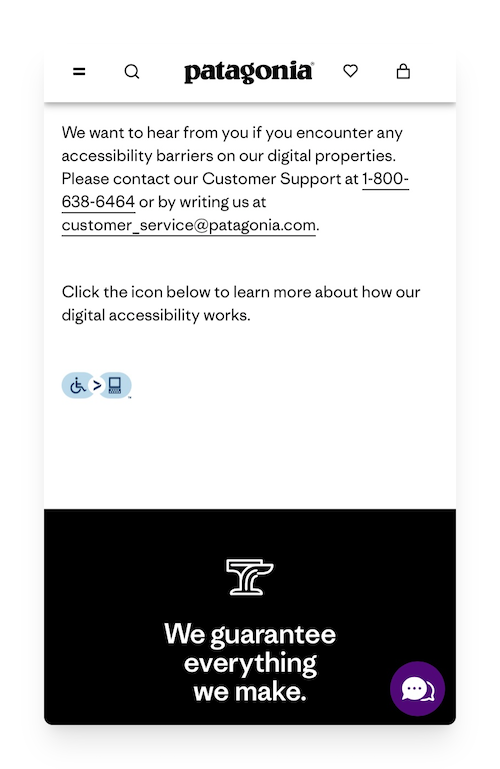
Source: Patagonia
Prioritizing accessibility improves user satisfaction, reduces bounce rates, and enhances brand reputation, while also ensuring compliance with legal standards like theAmericans with Disabilities Act (ADA).
8. Online shopping via voice apps is growing in popularity
Personal digital assistants like Alexa and Siri are no longer a novelty. They’re increasingly used in everyday life in a variety of ways, and this now includes making purchases on the internet.
According to The Business Research Company, the voice commerce market size is predicted to reach about $151.4 billion in 2025. Furthermore, this market is predicted to increase at a compound annual growth rate of 29.2%, amounting to an estimated $421.7 billion in 2029.
Product research and buying via voice commands are expected to increase dramatically in the years ahead. Keep in mind that voice commands can also be completed conveniently via a smartphone and do not necessarily require a smart speaker or another special device.
Your website and mobile app must be configured properly to accommodate those wanting to make purchases via this method.
9. Brands are taking advantage of innovations in mobile chatbots
Chatbots provide businesses with a cost-effective way to improve customer service. They are available to customers at all hours of the day so that they can receive support regardless of when they’re making a purchase.
As the technology used in chatbots has dramatically improved, online shoppers often prefer to interact with them rather than contact a live customer-service representative.
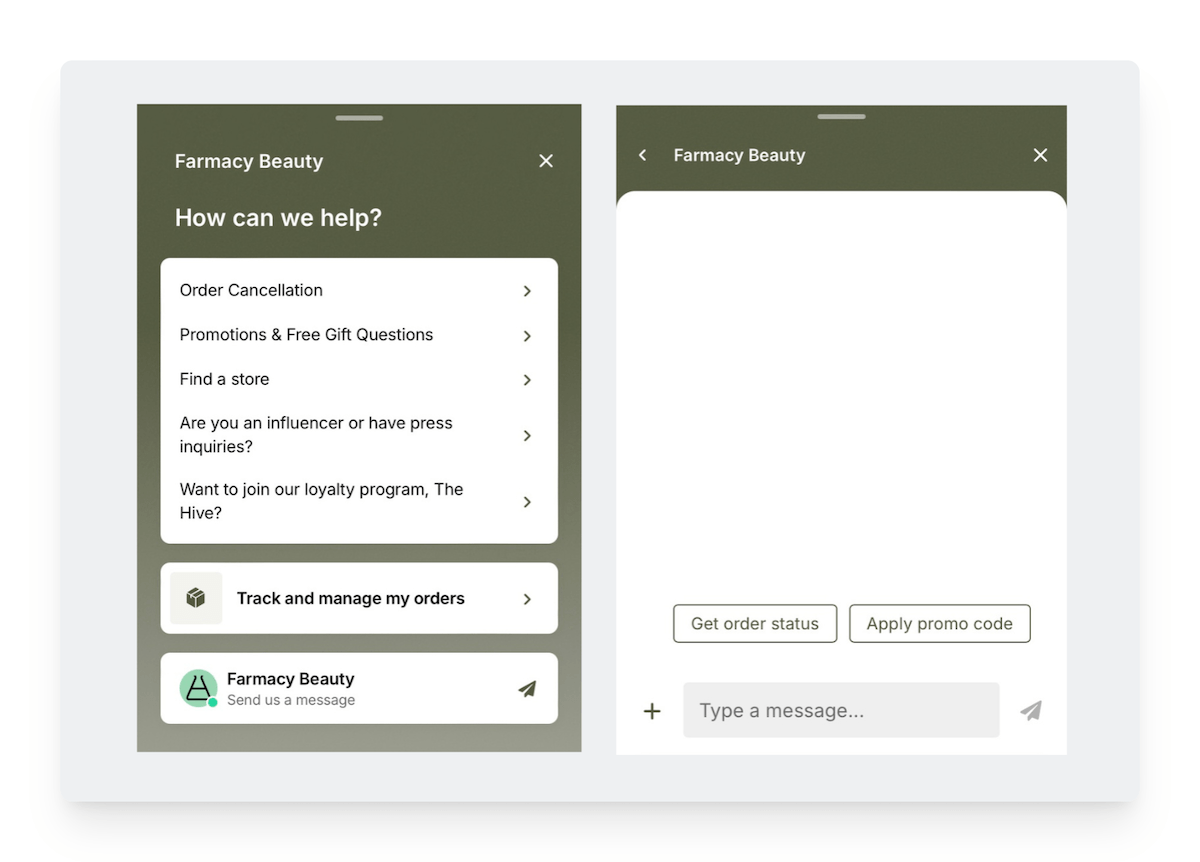
Interacting with Farmacy Beauty's chatbot on a mobile device
Today, chatbots are not yet universally used by all ecommerce businesses on their desktop-accessible websites. Because of an increase in consumer preference and changing expectations, this may need to be a part of your development efforts for your site.
Furthermore, the trend is likely to carry over to apps. As you design a new mobile app or upgrade your existing one, this is an important feature to consider adding.
10. Augmented reality (AR) technology is becoming more prevalent
As popular as ecommerce and m-commerce are, they have some serious limitations. For example, buyers have only been able to visualize products via a two-dimensional image or through video footage in some cases until recently.
The trend toward incorporating AR into shopping apps is growing, and it can have a powerful impact on a user’s purchasing experience.
Some of the many uses for augmented reality in apps is to showcase the size and color of furniture in a shopper’s living space. Through the technology used here and in other ways, consumers can make smarter buying decisions.
It can improve shoppers’ experiences by elevating their confidence in the items that they’ve selected and can also lower return rates.
11. More businesses are allowing for mobile in-store checkout
If you have an internet presence as well as a brick-and-mortar store, you should still take advantage of the convenience of a mobile checkout. The one-click checkout process that today’s shoppers appreciate with app purchases can extend to other types of activities.
For example, there is a growing trend for stores to offer one-click mobile checkouts in their physical locations.
A mobile in-store checkout gives customers the ability to avoid long lines at brick-and-mortar locations. This saves time, reduces stress, and enhances the benefits of making in-store purchases.
Many customers appreciate the speed and convenience of mobile shopping with a speedy checkout. However, they also enjoy the ability to physically interact with merchandise in stores before making a purchase. A mobile in-store checkout process offers users the benefits of both options.
Stores can also take advantage of their mobile app to market to customers. For example, customers could receive a push notification telling them about item availability or specials as soon as they enter the shop.
12. Fraud in mobile shopping remains a challenge
While buyers are becoming more confident about their ability to shop safely with reputable sites, they’re aware of the dangers associated with cybercrime and fraud. The unfortunate reality is that the majority of fraudulent activities that occur on a daily basis are associated with mobile devices.
Regardless of how well-protected your site is, you must take reasonable steps to protect shoppers buying items on their phones. All brands and all shoppers can be exposed to cybercrime.
However, there are steps that you can take to elevate the protection of your online retail business and your customers.
App purchases are generally more secure than those completed online, and you can take this security to a new level. For example, using two-factor authentication with app activities can dramatically reduce the risk of being victimized by criminals.
13. Brands are using zero-party data for personalization
Zero-party data refers to information that customers intentionally and proactively share with a brand, such as preferences, interests, purchase intentions, and feedback. Unlike first-party data, which is collected through user behavior, zero-party data is voluntarily provided, making it more accurate and trustworthy.
More brands are leveraging zero-party data for personalization as consumers demand greater privacy and control over their information. This trend is crucial in mobile commerce, where personalization drives engagement and conversions. With increasing data privacy regulations (like GDPR and CCPA), relying on user-consented data helps brands build trust while delivering relevant experiences.
Your brand can use zero-party data in several ways for m-commerce:
- Personalized product recommendations based on user preferences.
- Targeted offers and discounts based on customer interests.
- Customized content in mobile apps or emails.
- Interactive quizzes and surveys to gather preferences.
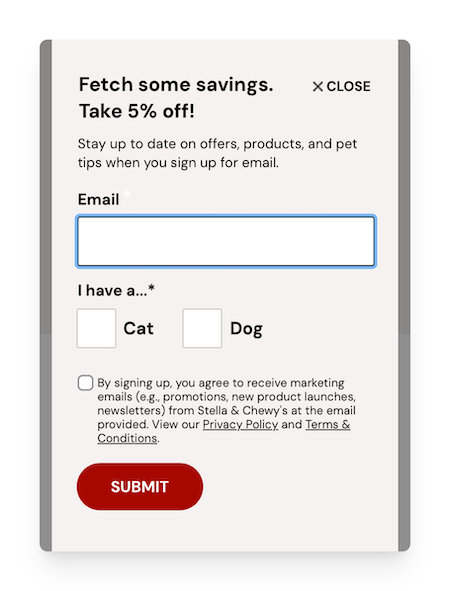
Stella & Chewy’s gives visitors a 5% discount after they provide their email address and other info
14. Mobile payments are more popular than ever
The popularity of mobile wallets has increased in recent years thanks to the security and the convenience that they bring to the table. These wallets include Android Pay, Apple Pay, and others.
These and other forms of digital wallets are accessible for purchasing on the internet as well as purchasing in stores. Besides accessing the wallets via a smartphone or tablet, shoppers can connect to their digital wallets through an Apple Watch and other connected wearables.
Stores must give site visitors access to their preferred payment methods. This is particularly important when their preferred payment methods add to their convenience and security.
If your website doesn’t already let visitors pay via mobile wallets, you should try to add this feature as soon as possible, seeing as it’s one of ecommerce’s top payment trends. Mobile wallets should be accessible via apps, on sites, and in brick-and-mortar locations.
15. Omnichannel integrations are improving
Mobile commerce plays a key role in a well-crafted omnichannel retail strategy by enabling seamless shopping experiences across digital and physical touchpoints.
Consumers expect to browse, buy, and interact with brands effortlessly, whether on a smartphone, website, social media, or in-store. M-commerce strengthens omnichannel integration by offering convenience, personalization, and frictionless transactions.
Brands are improving omnichannel integrations with innovations like mobile apps with in-store features (e.g., scan-and-go, AR try-ons), real-time inventory tracking, and AI-driven chatbots for customer support. Unified commerce platforms now sync data across channels, ensuring smooth transitions from online to offline experiences.
This is an important m-commerce trend because mobile is the primary shopping tool for many consumers. A strong omnichannel strategy boosts engagement, conversion rates, and customer loyalty while meeting the demand for convenience and immediacy.
If your digital commerce site also has a physical location, here are a few different ways to integrate mobile commerce in your omnichannel strategy:
- Mobile payments: Making payment methods like Apple Pay, Google Pay, etc. available provides shoppers with a faster checkout experience.
- In-app loyalty programs: Launching a loyalty program in your app makes it possible to reward customers across channels.
- Buy online, pick up in-store (BOPIS): Allowing customers to purchase items on your ecommerce site and then pick them up at a brick-and-mortar location close to them offers extra convenience.
- Personalized mobile marketing: Sending tailored messages, promotions, or reminders to users based on their preferences, behavior, or location via push notifications drives engagement and enhances the customer experience.
- QR codes and AR shopping: Allowing customers to access product details, virtual try-ons, or exclusive online content in-store are great tools for convincing them to buy, boosting your conversion rate.
Mobile commerce FAQ
What is mobile commerce?
Ecommerce is a broad term that refers to the buying and selling of goods on the internet. Mobile commerce, or m-commerce, describes online purchases that are specifically completed using smartphones and tablets.
Because of this, all m-commerce transactions are considered ecommerce, but not all ecommerce dealings can be categorized as m-commerce.
While some people refer to m-commerce as a growing trend, it should actually be viewed as an evolution of modern consumer behavior. This is because it’s not likely to disappear as trends often do.
In fact, it’s so prevalent and essential that it’s generated several new niche industries. A few of these spinoff industries include mobile payments, location-based services, and mobile marketing.
As an e-merchant, you can’t assume that simply having a mobile-responsive site is enough to cover all of your m-commerce marketing needs. Everything from your marketing to your checkout process may require special attention to meet this growing market.
What are the different types of transactions in mobile commerce?
Shoppers are able to complete multiple types of financial activities online using a mobile apparatus. Mobile commerce dealings can include banking, making payments, and online shopping.
- Mobile banking
The convenience of mobile banking has transformed how you can manage your finances. Through an app, you can check your bank account balance, initiate account transfers, deposit checks, view transaction details, and address other needs. These activities can also be completed on a mobile device through the browser.
- Mobile payments
Likewise, many consumers are now paying their bills online. This extends beyond accessing bill-pay functions through a bank’s mobile platform. It also includes making monthly payments for credit cards, utilities, rent or mortgage and more.
This added convenience helps people to better manage their funds and ensures that they take care of bills in a timely manner. It also eliminates the hassle of mailing checks to each company or provider that they do business with.
- Mobile shopping
Mobile shopping extends beyond purchasing clothes, home goods, and other essential items. Today’s shoppers can also buy groceries, order takeout food, and even purchase a new car through a mobile device. Besides occurring on websites and apps, mobile purchases can be completed via some of the more popular social media platforms.
What is the importance of mobile commerce and its growth?
The prevalence of this form of commerce is important to your online retail business for several reasons. Understanding the key advantages of mobile commerce may reveal why it’s advantageous to keep tabs on the trends in this area going forward.
First, it enables consumers to comparison-shop for goods that meet their needs without having to sit in front of a desktop or visit a local store. As convenient as it is to buy on the internet, it’s even easier to make a purchase through a handheld device that’s available at your fingertips.
Through m-commerce, shoppers can find the best deal available while feeling supported by chatbots, augmented reality, and other mobile technologies from anywhere and at any hour.
Second, the tremendous growth in this form of commerce, which has been changing how people buy online, is expected to continue.
By delivering an improved m-commerce experience in the months and years ahead, internet retailers can better cater to users purchasing on their phones. This will likely lead to a higher conversion rate and more revenue for these brands.
Another benefit that stores can enjoy when they focus on m-commerce is that they can be accessible to their customers at all times. Besides being available through a company’s own site, products can be obtained via social media apps, Amazon, and other platforms.
Making your site accessible in a variety of ways is an excellent way to help boost sales.
A final and critical benefit is the ability to accept multiple types of payments. Online shoppers can utilize Apple Pay, Visa Checkout, PayPal, Google Pay, and other methods to complete a transaction conveniently and securely on mobile devices. By doing so, they can avoid entering shipping info and credit card details manually.
What are the major benefits for your business of knowing the latest mobile commerce trends?
It doesn’t appear as if mobile commerce is going anywhere anytime soon. As the owner of an online store, it’s essential that you stay on top of changing customer preferences and expectations.
As mobile shopping continues to dominate, with smartphones accounting for the majority of online purchases, businesses that track these trends can optimize their strategies for better engagement and sales.
Staying informed allows you to refine your mobile user experience, streamline payment options, and implement personalization tactics that increase customer satisfaction and loyalty. In addition, you will be able to identify emerging technologies like mobile wallets, voice search, or augmented reality to enhance the shopping experience.
By monitoring and adjusting to these developing mobile commerce trends, you can potentially reduce cart abandonment, increase revenue, and deliver other essential benefits for your business.
What is the future of mobile shopping and m-commerce?
With the aforementioned trends in mobile commerce, the evolution of technology can enhance the customer experience in various ways, including improving security, confidence, speed, and more.
A Statista study found that global mobile commerce sales amounted to about $1.7 trillion in 2023, which was over 50% of total e-tail sales. What’s more, m-commerce’s share of overall retail sales is expected to increase over time, reaching an estimated 63% by 2028.
With this in mind, it’s clear that evaluating your current m-commerce strategy and determining how to optimize your efforts in this area will be key to helping your ecommerce venture obtain greater levels of success!


